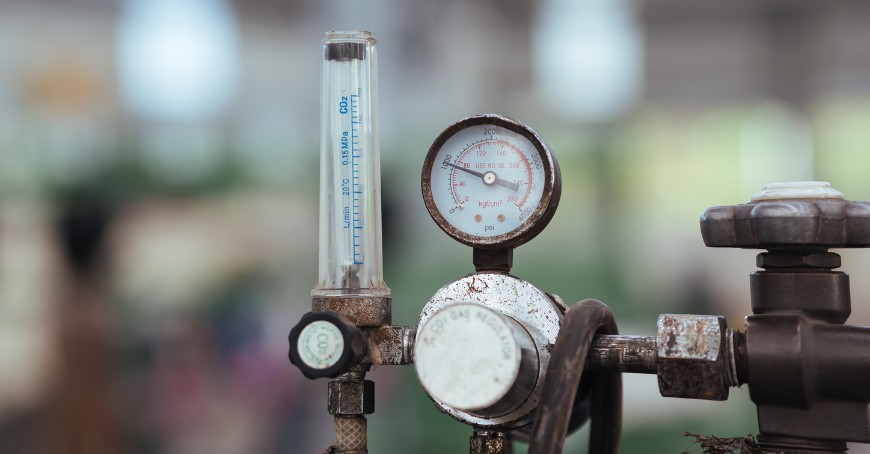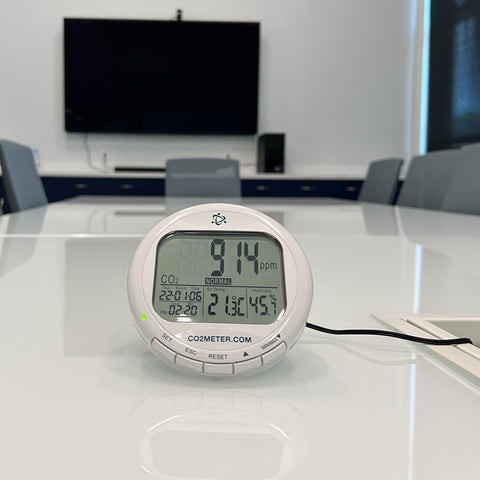What Level Of Co2 Is Dangerous? WHAT.EDU.VN provides clear insights into carbon dioxide safety levels, offering guidance for indoor air quality and safety. Discover thresholds, health risks, and ways to maintain a healthy environment.
1. Understanding CO2 Levels: An Overview
Carbon dioxide (CO2) is a naturally occurring gas, but elevated concentrations indoors can pose significant health risks. Understanding what level of CO2 is dangerous is crucial for maintaining safe and healthy environments. This guide explores the dangerous CO2 levels, their effects, and how to monitor and mitigate these risks. Maintaining optimal air quality involves more than just understanding CO2 levels; it also involves considering factors like ventilation rates and sources of carbon monoxide.
2. Normal CO2 Levels in the Atmosphere
The typical concentration of CO2 in outdoor air is around 400 parts per million (ppm) or 0.04%. This level is generally safe and serves as a baseline for indoor air quality assessments. Monitoring atmospheric carbon is important for understanding climate change and its environmental impact.
3. Acceptable CO2 Levels Indoors
What level of CO2 is dangerous in an indoor environment? Acceptable indoor CO2 levels typically range from 400 to 1,000 ppm. The specific levels depend on the setting:
- Homes: 400-1,000 ppm is considered acceptable.
- Offices and Classrooms: Maintaining levels below 800-1,000 ppm is recommended to prevent drowsiness and poor air quality.
- Workplaces: Guidelines set by organizations like ASHRAE and OSHA dictate permissible limits, often requiring levels no more than 700 ppm above outdoor air levels.
4. What is Considered a High CO2 Level?
CO2 levels exceeding 1,000 ppm can be considered high and may lead to adverse health effects. The severity of these effects increases with higher concentrations. According to the American Conference of Governmental Industrial Hygienists (ACGIH), exposure limits include an 8-hour Time-Weighted Average (TWA) Threshold Limit Value (TLV) of 5,000 ppm and a Ceiling exposure limit of 30,000 ppm for a 10-minute period.
5. Health Effects of Elevated CO2 Levels
What level of CO2 is dangerous to your health? Exposure to high CO2 levels can result in various symptoms and health conditions. The severity depends on the concentration and duration of exposure.
5.1. Mild Symptoms (1,000-2,000 ppm)
- Drowsiness
- Poor air quality perception
5.2. Moderate Symptoms (2,000-5,000 ppm)
- Headaches
- Fatigue
- Stagnant and stuffy air
- Poor concentration
- Increased heart rate
- Nausea
5.3. Severe Symptoms (Above 50,000 ppm)
- Oxygen deprivation
- Toxicity
5.4. Life-Threatening Symptoms (Above 100,000 ppm)
- Convulsions
- Coma
- Death due to oxygen deprivation
6. What Level of CO2 is Dangerous? Detailed Breakdown
To further clarify what level of CO2 is dangerous, consider this detailed breakdown:
| CO2 Level (ppm) | CO2 Level (%) | Effects |
|---|---|---|
| 400 | 0.04 | Normal outdoor air |
| 400-1,000 | 0.04-0.1 | Typical indoor levels; generally acceptable |
| 1,000-2,000 | 0.1-0.2 | Common complaints of drowsiness and poor air quality |
| 2,000-5,000 | 0.2-0.5 | Headaches, fatigue, poor concentration, increased heart rate, and nausea |
| >50,000 | >5 | Toxicity due to oxygen deprivation |
| >100,000 | >10 | Oxygen deprivation in seconds; convulsions, coma, and death |


7. Factors Influencing Indoor CO2 Levels
Several factors can affect indoor CO2 levels, including ventilation, occupancy, and sources of CO2.
7.1. Ventilation
Proper ventilation is crucial for diluting indoor CO2 concentrations. Ventilation systems should ensure adequate air exchange rates to maintain acceptable CO2 levels. Poorly maintained systems can lead to elevated CO2 concentrations.
7.2. Occupancy
The number of people in a space directly impacts CO2 levels. Each person exhales CO2, increasing the overall concentration. Higher activity levels also increase CO2 production per person.
7.3. Sources of CO2
Combustion appliances like gas stoves and heaters release CO2. Industrial processes can also contribute to elevated CO2 levels. Monitoring these sources and ensuring proper ventilation can help mitigate risks.
7.4. Indoor Plants
While plants absorb CO2 through photosynthesis, their impact on reducing indoor CO2 levels is generally small compared to ventilation and occupancy factors.
7.5. Building Structure and Insulation
Well-sealed buildings can trap CO2, leading to higher concentrations if ventilation is inadequate. Building materials may also absorb or release CO2, though this is typically a minor factor.
7.6. Outdoor Air Quality
External CO2 levels can influence indoor concentrations, especially if ventilation systems draw in air with high CO2 content. Weather conditions can also affect ventilation and air exchange rates.
7.7. Temperature and Humidity
Higher temperatures can increase CO2 emissions, and high humidity levels can affect ventilation system performance. Monitoring and managing these factors can help maintain indoor air quality.
7.8. Time of Day and Seasonal Changes
CO2 levels can fluctuate throughout the day based on occupancy patterns and ventilation practices. Seasonal changes can affect ventilation practices and outdoor air quality, impacting indoor CO2 levels.
7.9. Building Use and Function
Different types of buildings have varying CO2 generation sources and ventilation needs. Changes in building usage, such as increased occupancy or extended operating hours, can impact CO2 levels.
8. Real-World Example: A CO2 Incident
To illustrate the importance of monitoring CO2 levels, consider this real-world incident:
At CO2Meter, technicians were studying the effects of extremely low temperatures on carbon dioxide sensors using dry ice. After finishing their tests, they stored the dry ice in the company refrigerator. The next day, the first person to enter the building heard CO2 alarms indicating a problem. The CO2 level was 1,500 ppm – safe but noteworthy.
The staff discovered that the dry ice in the refrigerator’s freezer was off-gassing CO2 because the freezer’s temperature was warmer than the sublimation point of CO2. This incident highlighted the importance of CO2 monitoring and proper storage of materials that can release CO2.
9. Monitoring CO2 Levels: Tools and Techniques
Effective CO2 monitoring is essential for maintaining safe indoor environments. Various tools and techniques are available for measuring CO2 levels.
9.1. CO2 Monitors
CO2 monitors provide real-time measurements of CO2 concentrations. These devices are available in various forms, including portable monitors and fixed installations. The TIM10 Indoor Air Quality Monitor is an excellent option, providing measurements of CO2, relative humidity, and temperature.
9.2. Data Loggers
Data loggers record CO2 levels over time, providing valuable insights into trends and patterns. This data can help identify potential issues and optimize ventilation strategies.
9.3. Ventilation Systems
Advanced ventilation systems can automatically adjust airflow based on CO2 levels, ensuring optimal air quality. These systems often integrate with CO2 sensors for real-time monitoring and control.
10. Strategies for Reducing High CO2 Levels
What level of CO2 is dangerous can be managed through various strategies aimed at reducing CO2 levels and improving indoor air quality.
10.1. Improve Ventilation
Increasing the amount of fresh air entering a space can significantly reduce CO2 levels. This can be achieved through natural ventilation (opening windows and doors) or mechanical ventilation systems.
10.2. Optimize HVAC Systems
Ensure that HVAC systems are properly maintained and functioning efficiently. Regular filter replacements and system inspections can improve air quality and reduce CO2 levels.
10.3. Control Occupancy
Managing the number of people in a space can help prevent CO2 buildup. Implement strategies such as staggered schedules or remote work arrangements to reduce occupancy levels during peak times.
10.4. Manage CO2 Sources
Identify and manage sources of CO2, such as combustion appliances. Ensure that these appliances are properly vented to the outdoors to prevent CO2 from accumulating indoors.
10.5. Air Purifiers
Consider using air purifiers with CO2 filters to remove CO2 from the air. These devices can help maintain acceptable CO2 levels, especially in enclosed spaces with limited ventilation.
11. Regulatory Standards and Guidelines
Various regulatory standards and guidelines dictate acceptable CO2 levels in different environments.
11.1. ASHRAE Standards
ASHRAE (American Society of Heating, Refrigerating and Air-Conditioning Engineers) sets standards for indoor air quality, including recommendations for CO2 levels. These standards are widely used in commercial and industrial settings.
11.2. OSHA Guidelines
OSHA (Occupational Safety and Health Administration) provides guidelines for workplace safety, including permissible exposure limits for CO2. These guidelines are designed to protect workers from the health risks associated with high CO2 levels.
11.3. Building Codes
Different countries and regions have specific building codes that dictate acceptable indoor CO2 levels. It’s essential to check local regulations for compliance.
12. The Importance of Addressing High CO2 Levels
Understanding what level of CO2 is dangerous and addressing high CO2 levels is essential for several reasons:
- Health and Well-being: Maintaining acceptable CO2 levels promotes the health and well-being of occupants, reducing the risk of adverse health effects.
- Productivity: Lower CO2 levels can improve cognitive function and productivity, especially in office and classroom settings.
- Compliance: Adhering to regulatory standards and guidelines ensures compliance and prevents potential legal issues.
- Comfort: Proper ventilation and CO2 management can improve overall comfort levels in indoor environments.
13. Understanding Search Intent Behind “What Level of CO2 Is Dangerous”
When users search for “what level of CO2 is dangerous,” they typically have one of the following intentions:
- Information Seeking: They want to understand the specific CO2 concentration thresholds that pose a risk to health and safety.
- Troubleshooting: They may be experiencing symptoms or have concerns about indoor air quality and want to determine if CO2 levels are a contributing factor.
- Prevention: They are looking for ways to monitor and control CO2 levels in their homes, offices, or other indoor environments to ensure safety.
- Regulatory Compliance: Businesses and organizations need to understand permissible CO2 limits to comply with health and safety regulations.
- Educational Purposes: Students, researchers, and professionals in fields like environmental science or occupational health seek information for academic or professional reasons.
14. What.Edu.Vn: Your Resource for Clear Answers
At WHAT.EDU.VN, we understand the importance of clear, accessible information. If you have questions about air quality, environmental hazards, or anything else, we’re here to help.
15. Call to Action
Do you have questions about CO2 levels or other environmental concerns? Visit WHAT.EDU.VN today and ask your question for free. Our community of experts is ready to provide the answers you need.
Address: 888 Question City Plaza, Seattle, WA 98101, United States.
Whatsapp: +1 (206) 555-7890.
Website: what.edu.vn
